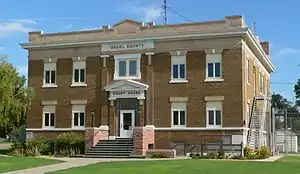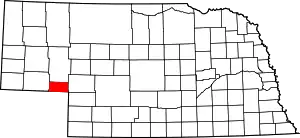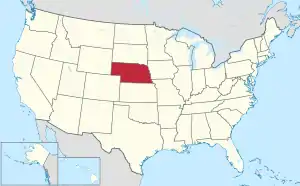Deuel County, Nebraska
Deuel County is a county located in the U.S. state of Nebraska. As of the 2010 United States Census, the population was 1,941.[1] Its county seat is Chappell.[2] The county was formed in 1889 and named for Harry Porter Deuel, superintendent of the Union Pacific Railroad.[3]
Deuel County | |
|---|---|
 Deuel County Courthouse in Chappell | |
 Location within the U.S. state of Nebraska | |
 Nebraska's location within the U.S. | |
| Coordinates: 41°07′N 102°20′W | |
| Country | |
| State | |
| Founded | 1889 |
| Named for | Harry P. Deuel |
| Seat | Chappell |
| Largest city | Chappell |
| Area | |
| • Total | 441 sq mi (1,140 km2) |
| • Land | 440 sq mi (1,100 km2) |
| • Water | 0.9 sq mi (2 km2) 0.2%% |
| Population | |
| • Estimate (2018) | 1,825 |
| • Density | 4.3/sq mi (1.7/km2) |
| Time zone | UTC−7 (Mountain) |
| • Summer (DST) | UTC−6 (MDT) |
| Congressional district | 3rd |
| Website | www |
In the Nebraska license plate system, Deuel County is represented by the prefix 78 (it had the 78th-largest number of vehicles registered in the county when the license plate system was established in 1922).
Geography
Deuel County lies on the south side of Nebraska. Its southern boundary abuts the northern boundary line of the state of Colorado. According to the US Census Bureau, the county has an area of 411 square miles (1,060 km2), of which 440 square miles (1,100 km2) is land and 0.9 square miles (2.3 km2) (0.2%) is water.[4]
Since Deuel County lies in the western portion of Nebraska, its residents observe Mountain Time. The eastern portion of Nebraska observes Central Time.
Major highways
Adjacent counties
- Garden County - north
- Keith County - east
- Perkins County - southeast
- Sedgwick County, Colorado - south
- Cheyenne County - west
Demographics
| Historical population | |||
|---|---|---|---|
| Census | Pop. | %± | |
| 1890 | 2,893 | — | |
| 1900 | 2,630 | −9.1% | |
| 1910 | 1,786 | −32.1% | |
| 1920 | 3,282 | 83.8% | |
| 1930 | 3,992 | 21.6% | |
| 1940 | 3,580 | −10.3% | |
| 1950 | 3,330 | −7.0% | |
| 1960 | 3,125 | −6.2% | |
| 1970 | 2,717 | −13.1% | |
| 1980 | 2,462 | −9.4% | |
| 1990 | 2,237 | −9.1% | |
| 2000 | 2,098 | −6.2% | |
| 2010 | 1,941 | −7.5% | |
| 2018 (est.) | 1,825 | [5] | −6.0% |
| US Decennial Census[6] 1790-1960[7] 1900-1990[8] 1990-2000[9] 2010-2013[1] | |||
As of the 2000 United States Census,[10] there were 2,098 people, 908 households, and 601 families in the county. The population density was 5 people per square mile (2/km2). There were 1,032 housing units at an average density of 2 per square mile (1/km2). The racial makeup of the county was 97.33% White, 0.05% Black or African American, 0.38% Native American, 0.38% Asian, 1.14% from other races, and 0.71% from two or more races. 2.72% of the population were Hispanic or Latino of any race. 36.3% were of German, 10.7% Irish, 10.2% English, 10.0% Swedish and 9.5% American ancestry.
There were 908 households, out of which 25.60% had children under the age of 18 living with them, 57.60% were married couples living together, 5.90% had a female householder with no husband present, and 33.80% were non-families. 31.20% of all households were made up of individuals, and 16.50% had someone living alone who was 65 years of age or older. The average household size was 2.29 and the average family size was 2.87.
The county population contained 23.30% under the age of 18, 4.90% from 18 to 24, 24.40% from 25 to 44, 24.50% from 45 to 64, and 22.90% who were 65 years of age or older. The median age was 44 years. For every 100 females there were 94.80 males. For every 100 females age 18 and over, there were 95.50 males.
The median income for a household in the county was $32,981, and the median income for a family was $41,550. Males had a median income of $26,020 versus $19,479 for females. The per capita income for the county was $17,891. About 5.30% of families and 9.10% of the population were below the poverty line, including 12.40% of those under age 18 and 6.10% of those age 65 or over.
Communities
- Barton
- Big Springs
- Chappell (county seat)
Politics
Deuel County voters have been strongly Republican for decades. In no national election since 1936 has the county selected the Democratic Party candidate (as of 2020).
| Year | Republican | Democratic | Third Parties |
|---|---|---|---|
| 2020 | 84.2% 871 | 13.6% 141 | 2.1% 22 |
| 2016 | 82.2% 809 | 12.2% 120 | 5.6% 55 |
| 2012 | 75.0% 763 | 21.1% 215 | 3.8% 39 |
| 2008 | 73.7% 732 | 24.5% 243 | 1.8% 18 |
| 2004 | 77.9% 820 | 21.1% 222 | 1.0% 11 |
| 2000 | 75.8% 783 | 20.6% 213 | 3.6% 37 |
| 1996 | 63.5% 629 | 24.7% 245 | 11.8% 117 |
| 1992 | 49.8% 558 | 20.7% 232 | 29.5% 330 |
| 1988 | 71.2% 769 | 28.0% 302 | 0.8% 9 |
| 1984 | 82.4% 962 | 17.0% 198 | 0.6% 7 |
| 1980 | 77.5% 946 | 15.7% 192 | 6.7% 82 |
| 1976 | 65.2% 776 | 33.4% 398 | 1.4% 17 |
| 1972 | 81.7% 1,001 | 18.3% 224 | |
| 1968 | 75.3% 997 | 18.9% 250 | 5.9% 78 |
| 1964 | 64.6% 972 | 35.4% 533 | |
| 1960 | 76.2% 1,276 | 23.8% 398 | |
| 1956 | 79.9% 1,165 | 20.2% 294 | |
| 1952 | 85.1% 1,372 | 14.9% 241 | |
| 1948 | 71.7% 1,043 | 28.3% 412 | |
| 1944 | 73.5% 1,125 | 26.5% 406 | |
| 1940 | 67.2% 1,156 | 32.8% 565 | |
| 1936 | 41.3% 747 | 56.4% 1,020 | 2.3% 41 |
| 1932 | 35.7% 630 | 61.9% 1,093 | 2.4% 42 |
| 1928 | 74.4% 1,197 | 25.1% 403 | 0.6% 9 |
| 1924 | 58.2% 775 | 23.7% 316 | 18.0% 240 |
| 1920 | 64.8% 684 | 30.4% 321 | 4.7% 50 |
| 1916 | 33.3% 181 | 62.5% 340 | 4.2% 23 |
| 1912 | 16.8% 64 | 35.3% 135 | 47.9% 183 |
| 1908 | 56.1% 526 | 41.8% 392 | 2.1% 20 |
| 1904 | 72.2% 399 | 19.7% 109 | 8.1% 45 |
| 1900 | 61.3% 403 | 36.7% 241 | 2.0% 13 |
References
- "State & County QuickFacts". US Census Bureau. Archived from the original on June 7, 2011. Retrieved September 19, 2013.
- "Find a County". National Association of Counties. Archived from the original on 31 May 2011. Retrieved 7 June 2011.
- Gannett, Henry (1905). The Origin of Certain Place Names in the United States. Govt. Print. Off. p. 105.
- "2010 Census Gazetteer Files". US Census Bureau. August 22, 2012. Archived from the original on November 13, 2013. Retrieved December 6, 2014.
- "Population and Housing Unit Estimates". Retrieved December 28, 2019.
- "US Decennial Census". US Census Bureau. Retrieved December 6, 2014.
- "Historical Census Browser". University of Virginia Library. Retrieved December 6, 2014.
- "Population of Counties by Decennial Census: 1900 to 1990". US Census Bureau. Retrieved December 6, 2014.
- "Census 2000 PHC-T-4. Ranking Tables for Counties: 1990 and 2000" (PDF). US Census Bureau. Retrieved December 6, 2014.
- "U.S. Census website". US Census Bureau. Retrieved 31 January 2008.
- Election Results
